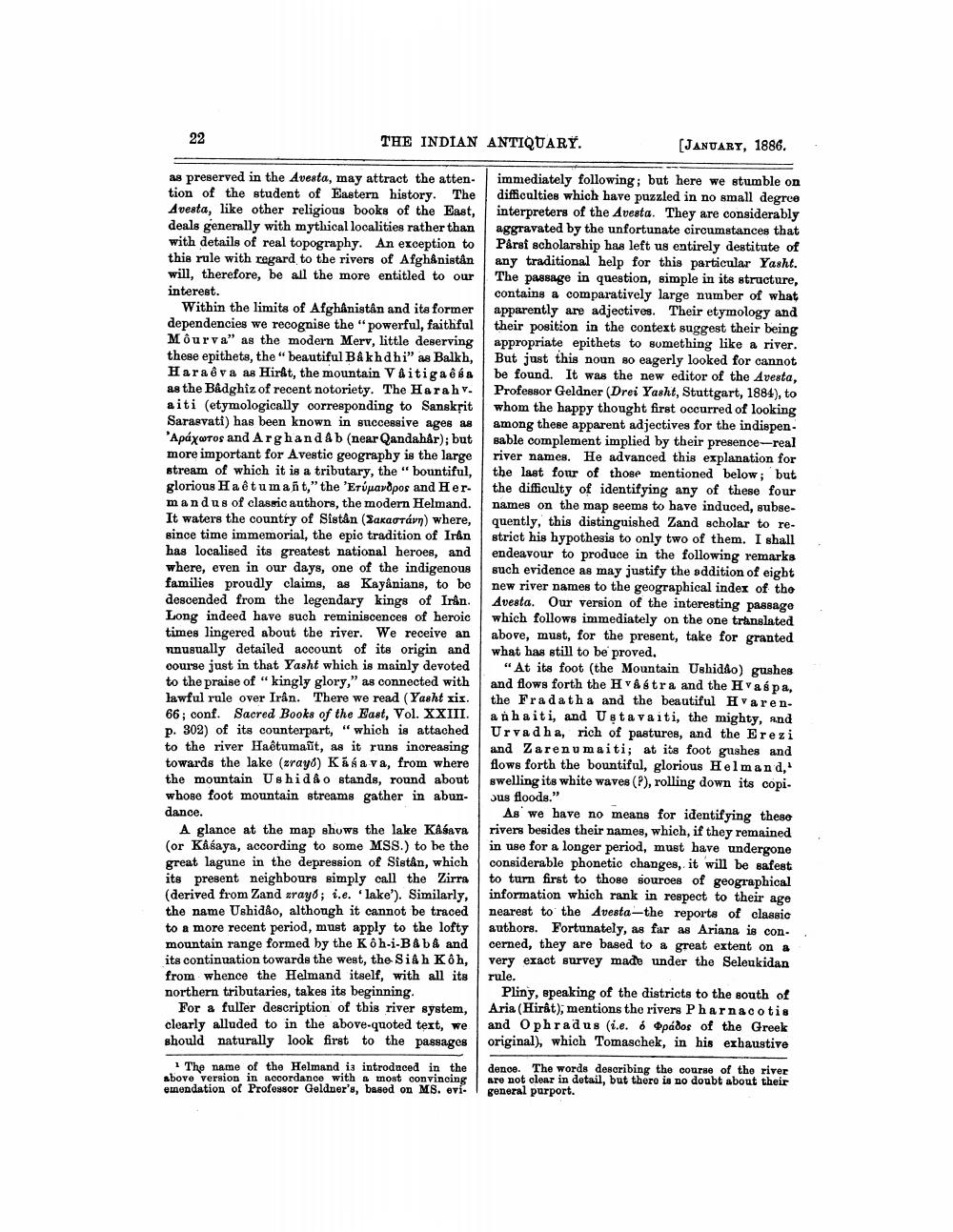________________
22
THE INDIAN ANTIQUARY.
(JANUARY, 1886.
as preserved in the Avesta, may attract the atten- tion of the student of Eastern history. The Avesta, like other religious books of the East, deals generally with mythical localities rather than with details of real topography. An exception to this rule with regard to the rivers of Afghanistan will, therefore, be all the more entitled to our interest.
Within the limits of Afghanistan and its former dependencies we recognise the powerful, faithful MÔurva" as the modern Merv, little deserving these epithets, the beautiful Bakhdhi" as Balkh, Hara êva as Hirst, the mountain Vitiga ê é a as the Badghiz of recent notoriety. The Harahv. aiti (etymologically corresponding to Sansksit Sarasvati) has been known in successive ages as 'Apáxwtos and Arghand&b (near Qandahår); but more important for Avestic geography is the large stream of which it is a tributary, the "bountiful, glorious H aêtumast," the 'ETúpavopos and Her mandus of classic authors, the modern Helmand. It waters the country of Sistån (Sakaurávn) where, since time immemorial, the epic tradition of Irån has localised its greatest national heroes, and where, even in our days, one of the indigenous families proudly claims, as Kayânians, to be descended from the legendary kings of Iren. Long indeed have such reminiscences of heroic times lingered about the river. We receive an unusually detailed account of its origin and course just in that Yasht which is mainly devoted to the praise of "kingly glory," as connected with lawful rule over Irån. There we read (Yasht zis. 66; conf. Sacred Books of the East, Vol. XXIII. p. 302) of its counterpart, "which is attached to the river Haộtumalt, as it runs inoreasing towards the lake (xray) Kása va, from where the mountain Ushid&o stands, round about whose foot mountain streams gather in abundance.
A glance at the map ahuws the lake Kåsava (or Kåsaya, according to some MSS.) to be the great lagune in the depression of Sistan, which its present neighbours simply call the Zirra (derived from Zand wrayo; i.e. lake'). Similarly, the name Ushidao, althongh it cannot be traced to a more recent period, must apply to the lofty mountain range formed by the Koh-i-B&b & and its continuation towards the west, the Siah Koh, from whence the Helmand itself, with all its northern tributaries, takes its beginning.
For a fuller description of this river system, clearly alluded to in the above-quoted text, we should naturally look first to the passages
immediately following; but here we stumble on difficulties which have puzzled in no small degree interpreters of the Avesta. They are considerably aggravated by the unfortunate circumstances that Pârst scholarship has left us entirely destitute of any traditional help for this particular Yasht. The passage in question, simple in its structure, contains a comparatively large number of what apparently are adjectives. Their etymology and their position in the context suggest their being appropriate epithets to something like a river. But just this noun so eagerly looked for cannot be found. It was the new editor of the Avesta, Professor Geldner (Drei Yasht, Stuttgart, 1884), to whom the happy thought first occurred of looking among these apparent adjectives for the indispenbable complement implied by their presence-real river names. He advanced this explanation for the last four of those mentioned below; but the difficulty of identifying any of these four names on the map seems to have induced, subsequently, this distinguished Zand scholar to restrict his hypothesis to only two of them. I shall endeavour to produce in the following remarks such evidence as may justify the addition of eight new river names to the geographical index of the Avesta. Our version of the interesting passage which follows immediately on the one translated above, must, for the present, take for granted what has still to be proved.
"At ita foot (the Mountain Ushidao) gushes and flows forth the Hrastra and the Hvaspa, the Fradatha and the beautiful Hvaren. a haiti, and Ustavaiti, the mighty, and Urvadha, rich of pastures, and the Erezi and Zareny maiti. At ita foot omahea and flows forth the bountiful, glorious Helmand, swelling its white waves (?), rolling down its copi. Jus floods."
As we have no means for identifying these rivers besides their names, which, if they remained in use for a longer period, must have undergone considerable phonetic changes, it will be safest to turn first to those sources of geographical information which rank in respect to their age nearest to the Avesta--the reports of classic authors. Fortunately, as far as Ariana is con. cerned, they are based to a great extent on a very exact survey made under the Seleukidan rule.
Pliny, speaking of the districts to the south of Aria (Hirat); mentions the rivers Pharnacotis and Ophradus (i.e. ó opádos of the Greek original), which Tomaschek, in his exhaustive
· The name of the Helmand is introduced in the dence. The words describing the course of the river above version in accordance with e most convincing are not clear in detail, but there is no doubt about their emendation of Professor Geldner's, based on MS. oví. general purport.




